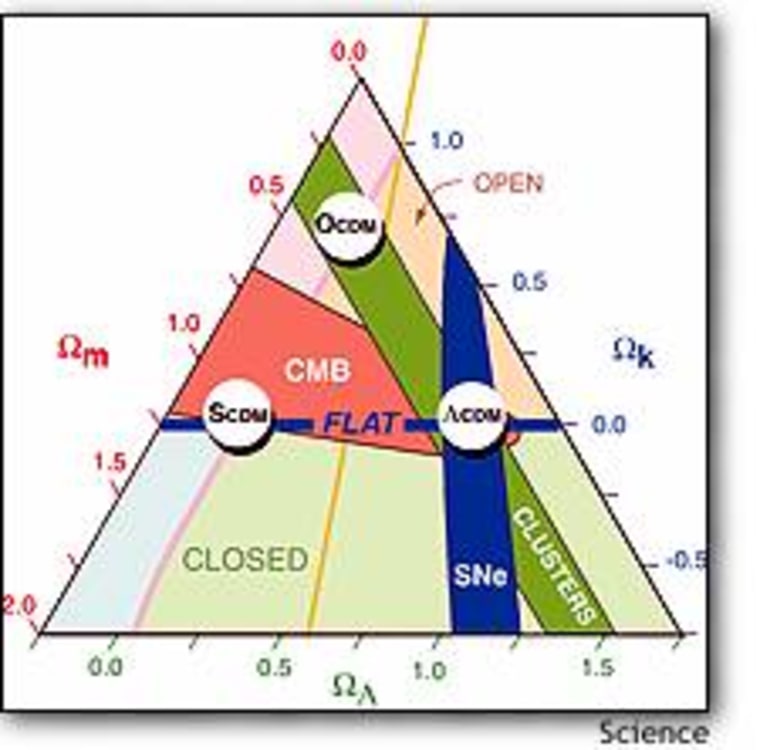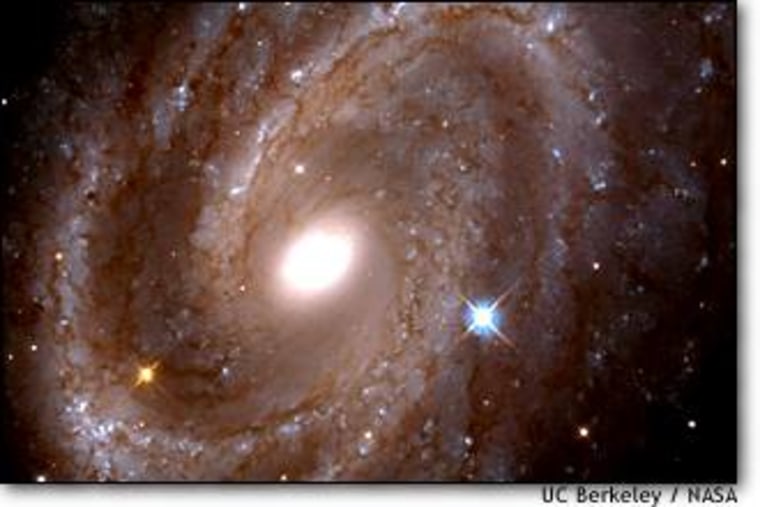After putting together surprising revelations about our universe, scientists are converging on a consistent view of the basics: a lightweight, accelerating cosmos that’s 12 billion to 15 billion years old, dominated by a mysterious “dark energy.” What’s the nature of such energy? Scientists say that puzzle will be one of their greatest challenges in the next millennium.
For millennia, thinkers have puzzled over basic questions about the universe: When and how was it created? How big is it? Does everything that we see account for everything that is? What’s going to happen to all this?
Scientists have developed theories to answer these ultimate questions, including the idea that the universe began with a rapid expansionary phase. This Big Bang model has been modified over time, but the observations to back up the theories are only now being drawn together.
The observations fall into three broad categories: the expansion rate of the universe, the matter density of the universe and the geometry of the universe.
In Friday’s issue of the journal Science, four scientists present a new graphical representation of these observations, dubbed the Cosmic Triangle. In the years ahead, the diagram could become as well-known to cosmologists as the Food Pyramid is to dietitians.

“Having these three key cosmological parameters led us to the idea of using a triangle to represent the universe,” said Princeton University’s Neta Bahcall, one of the Triangle’s creators. “It provides a clean way that has not been used up to now to really look at all the parameters together.”
The other authors are Princeton colleagues Jeremiah Ostriker and Paul Steinhardt, as well as Saul Perlmutter, head of the Supernova Cosmology Project at Lawrence Berkeley National Laboratory. Research focusing on the age and nature of the universe was released in advance of its normal publication date to coincide with a NASA briefing on the subject Tuesday.
Three-sided surprise
Fortunately for theoreticians, the Triangle’s three parameters seem to converge in one particular region.
“It’s enormously exciting to see that we can really use these new observations on many different directions to probe the universe almost to the beginning, and be able to come up with such remarkable results which seem to fit together, answering the questions we have been trying to answer for many decades,” Bahcall said. “While the result is enormously exciting, it’s not what we expected.”
Each of the parameters for measuring the universe holds surprises:
- How fast is the universe expanding? Scientists had expected that the universe’s expansion would run out of steam as time went on. Instead, observations of a particular standard type of supernova over a variety of distances indicated last year that the universe is expanding at an accelerating rate.
Tuesday’s NASA briefing focused on a new estimate for the rate of the universe’s expansion, known as the Hubble Constant. Astronomers charted Hubble Space Telescope observations of 800 Cepheid variable stars, as well as comparative brightnesses and structures of distant galaxies and supernovae, to come up with an estimate that they said was within 10 percent of the constant’s true value.
Based on eight years of such research, a team of 27 astronomers led by Wendy Freedman of the Carnegie Observatories set the value of the Hubble Constant at 70 kilometers per second per megaparsec. That means a typical galaxy should appear to be receding 70 km/sec (156,500 mph) faster for every megaparsec (3.3 million light-years) of distance from Earth.
Ed Weiler, NASA’s associate administrator for space science, noted that determining the constant’s value more accurately was among the highest scientific goals for the Hubble Space Telescope.
“This subject — the expanding universe and how fast it’s expanding — is one of great interest,” he told journalists. “I don’t think it’s an overstatement to say it’s probably the key reason we were able to sell the Hubble Space Telescope to Congress and to the American people.”
Although Freedman’s team portrayed their results as definitive within a 10 percent margin of error, estimates proposed by other researchers range from 55 to 90. Scientists said further observations should narrow the uncertainty even further.
- What’s the universe’s matter density? Scientists had assumed that there was at least enough matter to slow down the universe’s expansion. The first surprise was that there had to be a type of matter we couldn’t see — the so-called dark matter. And there was another surprise: Even when you take dark matter into account, there still wasn’t enough to make the most widely accepted theories turn out right.
- What’s the geometry of the universe? Such a lightweight universe would imply that its geometry was “curved,” or “open.” This may sound like an arcane point, but it posed a real puzzler for physicists because it required them to make unattractive adjustments in their theories about the beginnings of the universe. Data gathered by the Cosmic Background Explorer satellite, however, showed that the universe was not curved, but instead appeared to be flat, just as the theoreticians hoped.
When physicists added all this up, they came to the conclusion that there had to be some sort of “dark energy” or “vacuum energy” that exerted a negative pressure, opposed to the attractive force of gravity. The theories matched the observations if matter accounted for a third of the universe’s content, with this “dark energy” accounting for the other two-thirds.
“If this is the correct picture, that opens a whole slew of new and fundamental questions,” Bahcall said. “What is this exotic dark energy that makes the universe accelerate? Where did it come from? If it really exists, it comes from some basic fundamental physics that we don’t quite understand yet.”
And there are other questions: “What is the dark matter? Unfortunately we don’t know the answer to that,” Bahcall said. Among the leading candidates are theoretical particles yet to be detected experimentally, such as axions, photinos and higgsinos.
The universe's past and future
The three parameters described in the Cosmic Triangle can be combined to come up with an age estimate for the universe — and cosmologists discussed their latest estimates this week.
In Friday’s issue of Science, Charles Lineweaver, a physicist at the University of New South Wales in Australia, estimated that the Big Bang occurred 13.4 billion years ago, plus or minus 1.6 billion years. About 1.2 billion years after that beginning, the halo of our Milky Way galaxy formed, and 3.5 billion years later the galaxy’s disk formed, he said.
Freedman said her estimate of the Hubble Constant yielded a younger age — 12 billion years — but she acknowledged that the estimate didn’t take into account the potential effect of dark energy. Factoring in the current theories about the accelerating universe would bring the figure up to about 13.5 billion years, she said.
Such figures are on the low end of estimates for the universe’s age, but when the margin of error is taken into account, Lineweaver’s calculations would allow for an age of 15 billion years.
So what’s the bottom line here? Right now, the long-term forecast looks rather gloomy.
Over the course of hundreds of billions of years, even neighboring galaxies would fade into the dimness of extreme redshift, and the universe would become a “bleaker and bleaker place,” University of Chicago astronomer Michael Turner said.
“Just taking it at face value, the suggestion is that it looks as if the universe will expand forever and the mass density will get lower and lower, so eventually it will reach to nearly zero,” Bahcall said. “And if there really was this dark energy, the universe would be permeated with dark energy.”
But scientists are quick to add that this isn’t the final word: Over the next decade, additional data from the Sloan Digital Sky Survey, the Microwave Anisotropy Probe, the Planck mission and the Space Interferometry Mission will bring the Hubble Constant and the Cosmic Triangle into sharper focus. It could well be that dark energy is something that changes over time to adjust the balance of the universe. This variant on the dark energy concept is called “quintessence.”
Could new theories lead to the harnessing of dark energy, just as Einstein’s theories led to the development of nuclear power? Bahcall says it’s another good question without an answer.
“If we understand what it is and where it’s coming from, there may well be some applications,” she said. “Frequently in scientific research, you find unexpected results — and then there are unexpected applications for it.”
